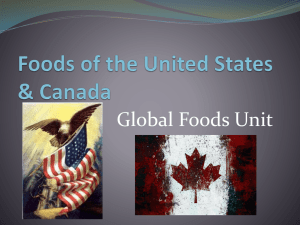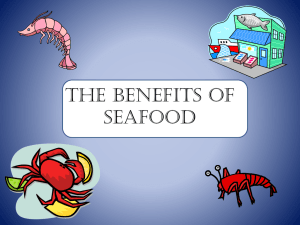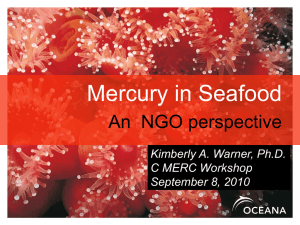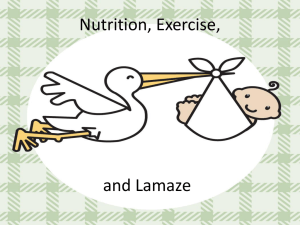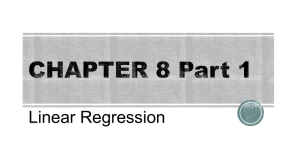Seafood at its Best Lecture
advertisement
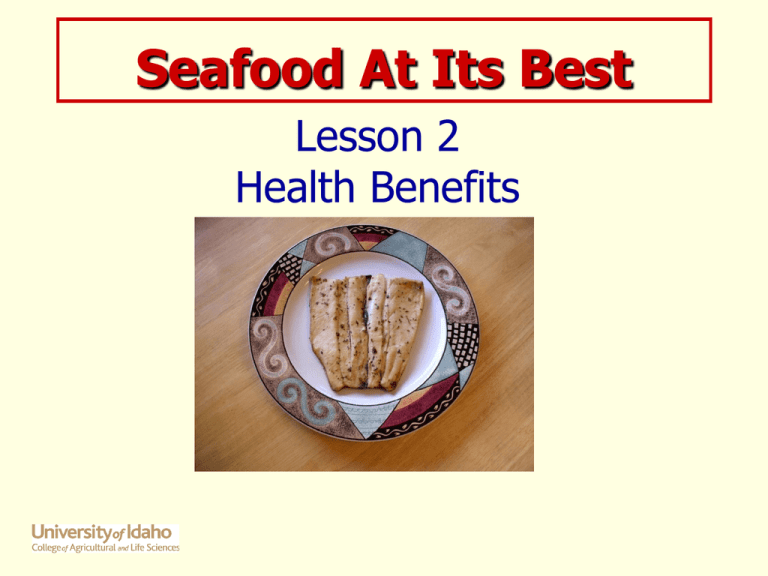
Seafood At Its Best Lesson 2 Health Benefits Lesson 2 - Goals Goals and Objectives • 2005 Dietary Guidelines • Health benefits of seafood • Seafood recommendations 2005 Dietary Guidelines – Make smart choices from each food group • Focus on fruits • Vary your vegetables • Get your calcium-rich foods • Make half your grains whole • Go lean with protein – Add more fish to your diet • Know the limits on fats, salt, and sugars 3 Go Lean with Protein • Choose lean meats and poultry • Bake it, broil it, or grill it • Vary your protein choices – with more fish, beans, peas, nuts and seeds 4 Health Benefits Associated with Fish Consumption and Levels of Supporting Evidence Disease or health condition Strong evidence of significant health benefits Coronary heart disease High blood pressure Irregular heart beat (arrhythmia) Diabetes Rheumatoid arthritis Promising preliminary results Asthma Bowel cancer Crohn’s disease Neural development 5 Health Benefits – Strong Evidence • Coronary heart disease • High blood pressure • Irregular heart beat • Diabetes • Rheumatoid arthritis 6 Seafood – Nutritional Benefits • • • • • High quality protein High in omega-3 fatty acids Low in saturated fat Contributes to a healthy heart Contributes to proper growth and development of children • Source of vitamins and minerals 7 High Quality Protein • Protein needed for growth and maintenance • Seafood contains all 9 essential amino acids • Protein is highly digestible • Fish contain 16-27 grams of protein 8 Omega-3 Fatty Acids Three types: Eicosapentaenoic acid (EPA) Seafood Docosahexaenoic acid (DHA) Seafood Alpha-linolenic acid (ALA) Flaxseed, wheat germ, dark leafy greens 9 Health Benefits of Omega-3 Fatty Acids Heart • • • • • Lowers triglyceride levels Counteracts inflammation Helps arteries stay elastic Helps prevent build-up of plaque deposits Reduces risk of dying from heart attack 10 Other Benefits of Omega-3 Fatty Acids • Joints – Fewer tender joints and decrease stiffness • Mood – Higher levels of EPA and DHA protective against depression • Mind – Perhaps caused by inflammation in center of the brain • Lungs – May decrease severity of asthma 11 Omega-3s and Diabetes • Onset of diabetes - May keep the immune system in check • Control of symptoms - Low level of DHA associated with an increased insulin resistance • Complications of diabetes - Influence development of cardiovascular disease - May delay onset of kidney and nerve complications 12 Omega-3s and Cancer • Onset - May help healthy cells resist damage • Multiplication of cells - May interfere with tumor growth • Spread - May inhibit tumor spread in the body 13 Omega-3 Oil Content Higher level (more than 1.0 gram) Herring Mackerel (Spanish) Salmon (king) Mackerel (Pacific and jack) Salmon (Atlantic) Salmon (pink) Tuna (bluefin) Medium level (between 0.5 and 1.0 gram) Fish Shellfish Bass (freshwater) Salmon (coho) Swordfish Blue mussels Bluefish Salmon (sockeye) Rainbow trout Oysters Mackerel (Atlantic) Smelt Whiting Salmon (chum) Striped bass 14 Omega-3 Oil Content Lower level (0.5 grams and less) Fish Shellfish Cod (Atlantic) Ocean perch Clams Flounder Pike (Northern) Blue crab Grouper Pollock (Atlantic) Dungeness crab Haddock Rockfish (Pacific) Snow crab Halibut Red snapper Northern Lobster Mahi-mahi Sea trout Spiny lobster Mullet Tuna (skipjack) Scallops Freshwater perch Tuna (yellowfin) Shrimp Note: All fish and shellfish were cooked by dry (baking, broiling, or microwaving) or moist (boiling, poaching, or steaming) cooking methods. 15 Low in Saturated Fat • Seafood is very low in fat – 3 grams per serving • Seafood preparation can add fat – Sauces – Deep-fat frying 16 Fat and Saturated Fat Content of Seafood and other Protein Foods 3-ounce edible portions, cooked Seafood Fat (grams) Sat. Fat (grams) 1 0 1 0 1 3.4 4 0 0.6 1 10 2 8 2 9 3 Chicken, dark meat, w/out skin, roasted Eggs, boiled Salmon, King 11 11 3 4 Pork loin, lean, roasted Mackerel, Atlantic/Pacific 13 14 25 44 5 10 7 Tuna, light, canned in water, drained, Pollock, broiled, skinless Shrimp, boiled Trout Salmon, Atlantic/Coho, baked, skinless Other Protein Foods Chicken, light meat, w/out skin, roasted Ground beef, extra lean Hot dog, beef Peanut butter 17 Fat Content Fat Content of 3-Ounce Cooked Portions of Fish and Shellfish Low fat – less than 3 grams total fat Clams Cod Blue crab Dungeness crab Flounder Grouper Haddock Halibut Northern lobster Mackerel (King) Mahi-mahi Monkfish Perch (freshwater) Ocean perch Pike (Northern) Walleye Pollock (Atlantic) Orange roughy Rockfish Scallops Shrimp Red Snapper Snow crab Smelt Sole Squid Striped bass Tuna (skipjack) Tuna (yellowfin) 18 Fat – Line Up Activity – Which of these fast-food items has the most fat? • • • • • • • Tuna wrap Chicken sandwich Seafood salad Medium French fries Filet-o-fish sandwich Quarter pound cheeseburger Fish sandwich with tartar sauce and cheese 19 Fat Line Up Answers • Chicken sandwich – 710 calories 43 grams of fat • Quarter pound cheeseburger – 530 calories 30 grams of fat • Fish sandwich with tartar sauce and cheese 523 calories 28 grams of fat • Med. French fries – 450 calories 20 grams of fat • Tuna wrap – 440 calories 32 grams of fat • Filet-o-fish – 400 calories 18 grams of fat • Seafood salad – 120 calories 5 grams of fat 20 Cholesterol Content of Seafood • Most fish and shellfish contain fewer than 100 milligrams of cholesterol per 3-ounce cooked serving • Many leaner types of fish have fewer than 50 milligrams per serving 21 Cholesterol Content Cholesterol Content of Seafood and Other Protein Food Seafood Cholesterol (mg) 0 Orange roughy 20 Halibut 35 Cod 45 Tuna, light, canned in water drained 45 Salmon, Atlantic, baked, skinless 50 Trout 58 Pollock, broiled, skinless Other Protein Foods Peanut butter 64 Chicken, dark and light meat, w/out skin, roasted 70 Ground beef, extra lean 77 Pork loin, lean, roasted 80 86 Shrimp, boiled (3-ounce edible portions, cooked) Hot dog, beef 165 362 Eggs, boiled 22 Sodium Content • Fish low in sodium • Fewer than 110 milligrams per 3-ounce cooked portion 23 Proper Growth and Development of Children • Omega-3s and pregnancy – During last trimester of pregnancy • Rapid synthesis of brain tissue • Omega-3s and premature infants – Risk factor for preterm delivery and low birth weight • Omega-3s and the newborn – DHA is influenced by the mother’s diet 24 Vitamins • Source of B complex vitamins Niacin, B12 and B6, Thiamin 25 Minerals • Excellent source of minerals Calcium, Iron Zinc, Copper, Potassium, Iodine, Phosphorus, Selenium, Magnesium 26 Fish or Fish Oil Supplements? • Taking supplements may be more convenient • Fish contains more of the “long-chain” fatty acid DHA • Excessive amounts of supplement – may increase bleeding • May also increase both good and bad cholesterol 27 The American Heart Association… • “Recommends that all adults eat fish (particularly fatty fish) at least two times a week” 28 Should We Eat Fish? • When – Institute of Medicine – The World Health Organization – Dietary Guidelines for Americans – NHLBI and NCEP – Countries around the world ALL RECOMMEND INCREASED FISH CONSUMPTION 29 Seafood – At Its Best “Do Your Health a Favor – Eat Seafood” 30
